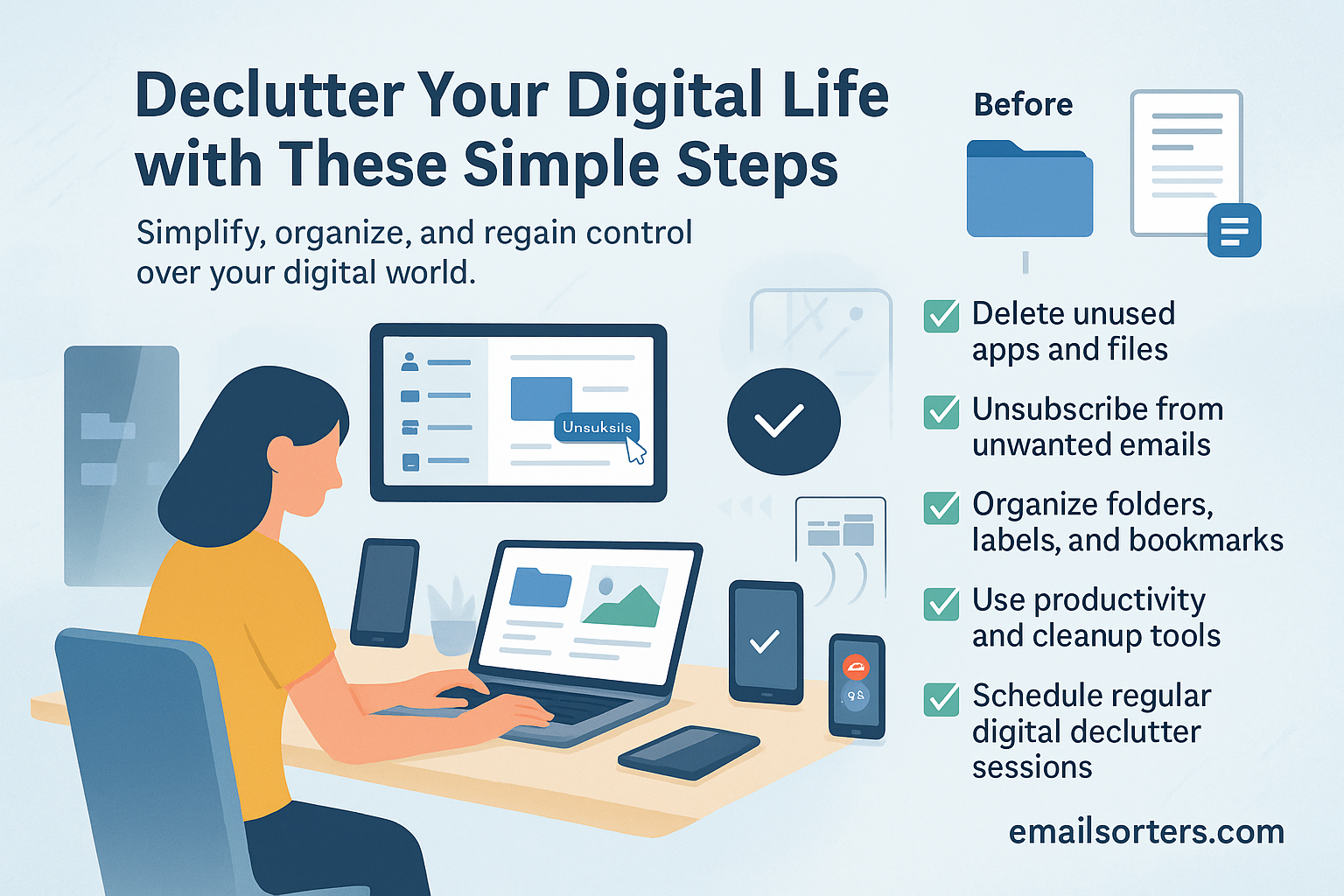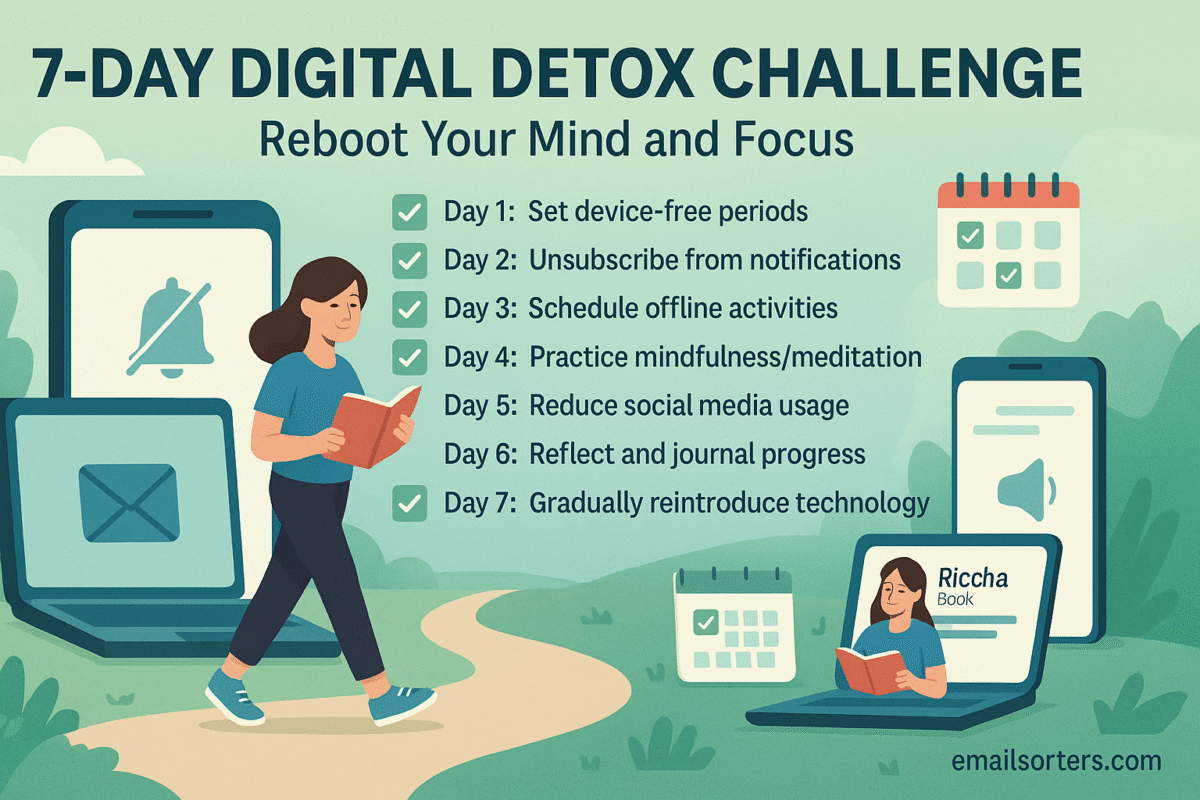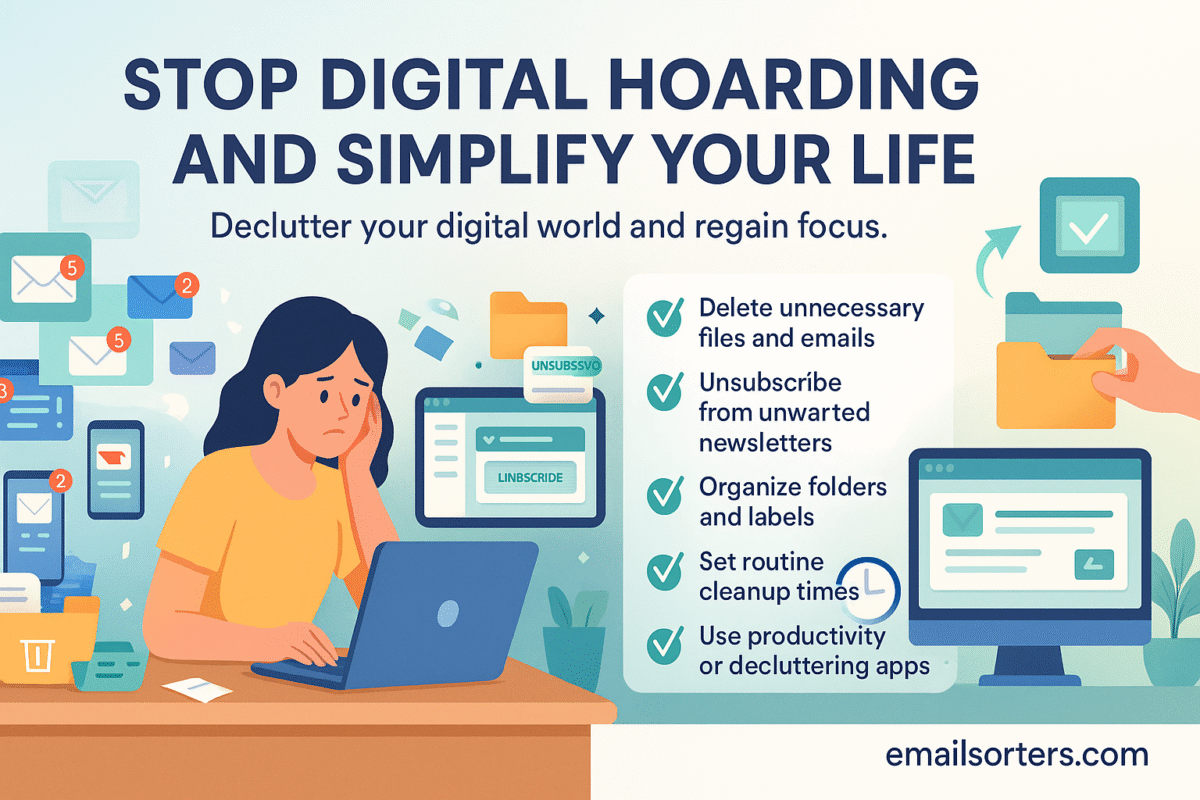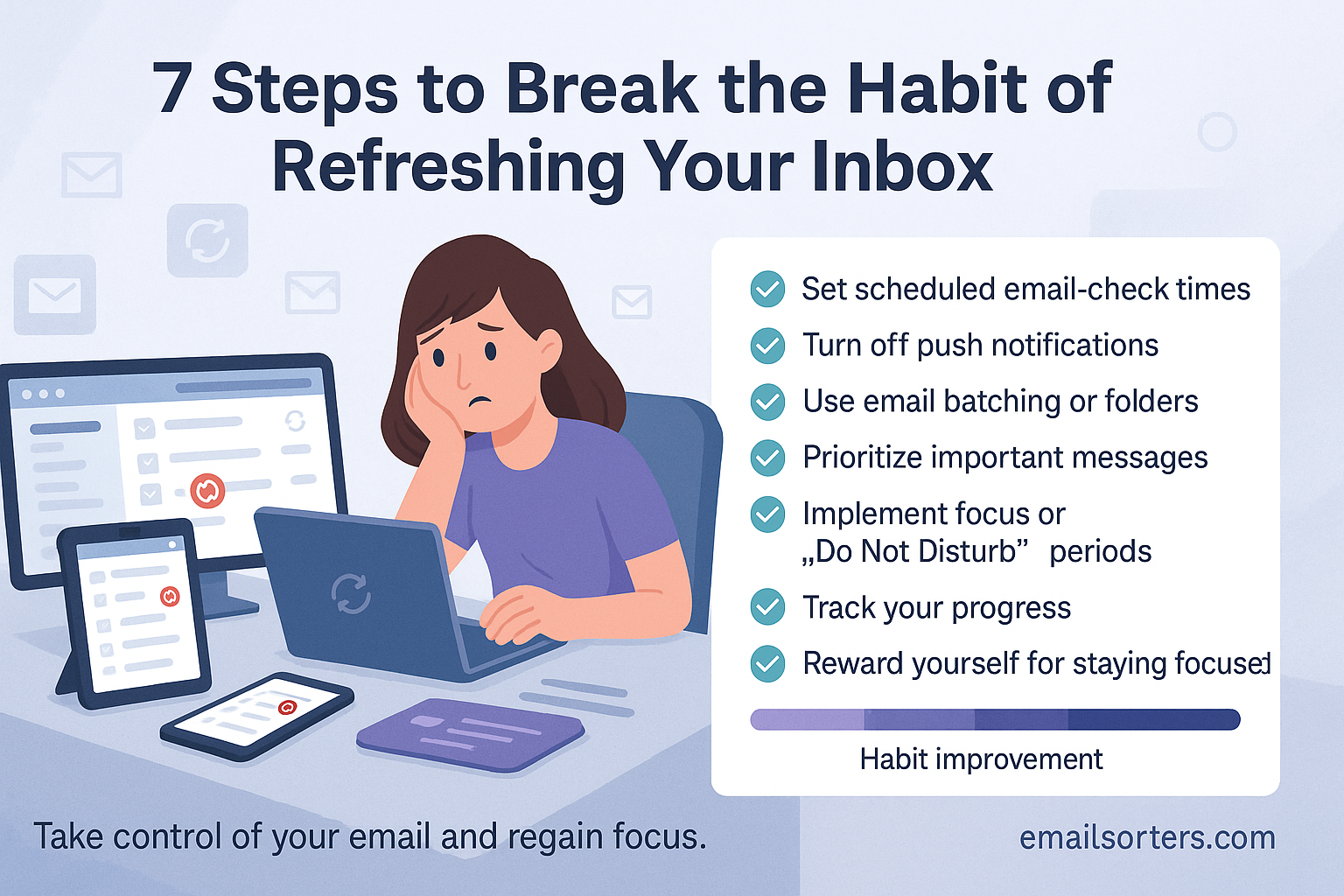Declutter digital life and you’ll be surprised how much lighter you feel. Between overflowing inboxes, endless notifications, messy files, and apps you forgot you even had, it’s no wonder digital chaos leaves us stressed and distracted.
The good news? You don’t have to delete everything or go off the grid. A few smart clean-up habits can make your devices and your mind feel a whole lot clearer.
From endless emails to crowded desktops, digital clutter can feel just as overwhelming as a messy room. It slows down devices, eats up time, and drains focus without you even realizing it. The good news? With a few simple steps, you can clear the digital mess and regain both mental clarity and productivity.
This guide will walk you through why digital clutter builds up, the benefits of decluttering, and practical steps to help you take back control of your digital space.
Why Digital Clutter Builds Up
The Hidden Impact of Digital Overload
Digital clutter doesn’t pile up like physical mess, so it’s easy to ignore until it starts slowing you down. Old files, endless photos, unused apps, and constant notifications quietly drain your time and energy. Unlike a messy desk you can see, digital clutter sneaks up and makes you feel overwhelmed without knowing why.
Common Sources of Digital Clutter
Most digital clutter comes from:
- Emails: newsletters, promotions, and old threads you never delete
- Files: downloads, duplicates, and outdated documents
- Apps: tools you installed once and never used again
- Photos: duplicates, blurry shots, and random screenshots
- Notifications: constant alerts that keep pulling your attention
Over time, these build up until your devices feel cluttered, slow, and stressful to use.
How Digital Mess Drains Mental Energy
Your brain works harder when your digital environment is messy. Just seeing a cluttered desktop or hundreds of unread emails creates background stress. Each notification splits your focus, and every time you search for a lost file, you lose valuable minutes. Clearing digital clutter reduces this invisible mental load, leaving you calmer and more focused.
The Benefits of a Digital Declutter
Improved Focus and Productivity
When your digital life is organized, you can find what you need instantly. No more wasted time digging through old downloads or scrolling through endless email threads. This clarity helps you focus on meaningful work instead of managing distractions.
Lower Stress and Mental Clarity
Digital clutter creates constant low-level stress. Decluttering removes that background noise. With fewer alerts, a tidy inbox, and a clean desktop, you’ll feel more in control of your day and less mentally drained.
Better Device Performance
A clean device isn’t just good for your mind; it’s good for your hardware. Fewer apps running in the background and less storage clutter mean faster performance, longer battery life, and fewer crashes.
Step 1 – Clean Up Your Inbox
Unsubscribe from Unnecessary Emails
The average person receives dozens of emails daily, many of which aren’t useful. Start by unsubscribing from newsletters and promotions you no longer read. Most emails have an “unsubscribe” link at the bottom. Aim to reduce the volume so only important messages reach your inbox.
Use Filters and Labels
Organize your inbox by creating filters. For example:
- Work emails go into a “Work” folder
- Bills and receipts go into “Finance”
- Newsletters go into “Read Later”
With labels or folders, you can focus on important emails first instead of drowning in clutter.
Set Daily Email-Check Windows
Instead of refreshing your inbox constantly, schedule 2–3 times a day to check it perhaps mid-morning, after lunch, and late afternoon. This keeps you responsive without letting email dictate your entire day.
Step 2 – Organize Your Files and Folders
Create a Simple Folder Structure
A clear folder system saves hours of searching. For example:
- Work → Projects, Reports, Presentations
- Personal → Bills, Health, Travel
- Media → Photos, Videos, Music
Keep the structure simple enough to remember but detailed enough to avoid chaos.
Delete or Archive Old Documents
Set aside time to go through your files. Delete duplicates, old downloads, and outdated versions. For items you want to keep but don’t use often, move them to an archive folder or external drive.
Use Cloud Storage Wisely
Cloud services like Google Drive or Dropbox are great for storage but they can also become cluttered. Regularly review and clean your cloud files. Store only what you truly need, and organize them with the same folder structure you use locally.
Step 3 – Tidy Up Your Smartphone
Delete Unused Apps
Go through your phone and remove apps you haven’t used in months. Not only do they take up storage, but many also run background processes that slow your phone down. Keep only the ones that add value to your daily life.
Turn Off Non-Essential Notifications
Constant pings are a major source of digital stress. Disable notifications for apps that aren’t urgent. Keep alerts only for essentials like calls, messages, or calendar reminders.
Organize Apps by Category
Group apps into folders such as Social, Work, Finance, and Health. This reduces visual clutter and makes it easier to find what you need. Place the most important apps on your home screen, and move distracting ones further away.
Step 4 – Streamline Your Social Media
Unfollow Accounts That Don’t Add Value
Scrolling through endless posts eats up time and attention. Go through your social media accounts and unfollow or mute anyone whose content doesn’t inspire, inform, or genuinely interest you. The fewer irrelevant updates you see, the less tempted you’ll be to scroll mindlessly.
Limit Daily Social Media Time
Set a daily time limit for social media use. Many smartphones now allow you to set app timers. For example, you might limit yourself to 30 minutes per day. Once you hit the limit, the app locks until the next day, helping you stay in control.
Curate Your Feed for Positivity
Social media doesn’t have to be a source of stress. Follow accounts that share uplifting, educational, or motivational content. Replace endless news cycles with pages that bring real value to your life.
Step 5 – Clear Out Your Desktop and Browser
Organize Your Computer Desktop
A cluttered desktop can feel overwhelming. Aim for a clean, minimalist look. Create a few main folders and place related files inside them. For example:
- Work
- Personal
- In Progress
- Archive
Delete unnecessary shortcuts and keep only what you use daily.
Manage Bookmarks and Tabs
Browsers can quickly become chaotic with dozens of open tabs. Close any you’re not actively using, and save important ones to organized bookmark folders. For example: “Work Research,” “Shopping,” “Learning,” and “Entertainment.”
If you often work with many tabs, use extensions that group them into sessions you can return to later.
Use Productivity Extensions
Extensions like tab managers, distraction blockers, and password managers can simplify your browsing experience. Choose only the ones that truly support your goals to avoid adding unnecessary complexity.
Step 6 – Back Up and Secure Your Data
Set Up Automatic Backups
Imagine decluttering your digital life only to lose everything in a device crash. Protect your hard work by setting up automatic backups whether to an external drive or a secure cloud service. This ensures your files are safe even if something unexpected happens.
Update Passwords and Use a Manager
Weak or repeated passwords put your data at risk. Use a password manager to create and store strong, unique passwords for each account. This not only boosts security but also saves time when logging in.
Protect Your Privacy Online
Review your privacy settings on social media, email, and other apps. Limit what personal information is publicly visible, and remove any old accounts you no longer use. A clean digital life also means a safer one.
Step 7 – Create Healthy Digital Habits
Set Screen-Free Times
Designate parts of your day as phone- or computer-free. For example:
- The first hour after waking
- Meal times
- The last hour before bed
These breaks give your brain time to recharge and reduce dependence on constant digital stimulation.
Practice the One-Minute Rule
If a digital task takes less than a minute like deleting a spam email or filing a document do it immediately. This prevents small tasks from piling up into overwhelming clutter.
Schedule Monthly Digital Checkups
Just like cleaning your home, digital spaces need regular upkeep. Once a month, set aside 30 minutes to review your inbox, delete unused files, and update your security settings. Regular maintenance keeps clutter from sneaking back.
Staying Motivated After a Digital Declutter
Tracking the Benefits You Notice
Keep a simple journal of the changes you experience faster devices, less stress, better sleep, or more free time. Seeing the results reinforces your motivation to stick with it.
Rewarding Yourself for Milestones
Celebrate progress. For example, if you keep your inbox under 50 emails for a month, treat yourself to something you enjoy a nice meal, a new book, or a relaxing activity.
Joining a Community for Accountability
Consider joining online groups focused on digital minimalism or productivity. Sharing your progress and tips with others keeps you accountable and inspired.
Common Mistakes to Avoid
Trying to Declutter Everything at Once
Trying to clean your entire digital life in one day often leads to burnout. Instead, tackle one area at a time like your inbox today, your desktop tomorrow, and your phone this weekend.
Saving “Just in Case” Files
Many people keep files “just in case” they might need them. In reality, most are never used again. Be honest with yourself: if you haven’t touched it in a year, you probably don’t need it.
Ignoring Maintenance
One-time decluttering won’t last without regular upkeep. Skipping monthly checkups leads to clutter building back up. Treat maintenance as part of your routine, not an optional extra.
Conclusion
Digital clutter builds slowly, but its effects are powerful. From lost time to higher stress, it chips away at focus and well-being. The good news is that with small, consistent steps, you can take back control.
By cleaning up your inbox, organizing files, tidying your smartphone, streamlining social media, and setting healthy digital habits, you create a digital environment that supports not hinders your life. The process doesn’t have to be overwhelming. Focus on one step at a time, and within weeks you’ll notice your devices feel lighter, your mind clearer, and your days more productive.
The journey doesn’t end after one cleanup session. Keep up with monthly checkups, reward yourself for progress, and continue adjusting your systems as your life changes. A decluttered digital life is less about perfection and more about balance.
FAQs
How often should I declutter my digital life?
Most people benefit from a light checkup once a month and a deeper cleanup every 3–6 months. Regular upkeep prevents digital clutter from piling up again.
What’s the fastest way to clean up my inbox?
Start by unsubscribing from newsletters and promotional emails you no longer read. Then, use filters to automatically sort incoming messages into categories like Work, Personal, and Finance.
How do I stop downloading unnecessary apps?
Before downloading, ask yourself: “Will I use this at least once a week?” If the answer is no, skip it. Also, review your phone monthly to remove apps you haven’t used.
Is cloud storage safe for sensitive files?
Most cloud services are secure if you use strong passwords and two-factor authentication. For extra-sensitive files, consider encrypting them before uploading.
How do I keep my desktop clutter-free long-term?
Adopt the “one-minute rule”: if you download or create a file, immediately put it in the correct folder. Schedule a weekly 10-minute session to clear stray files.




